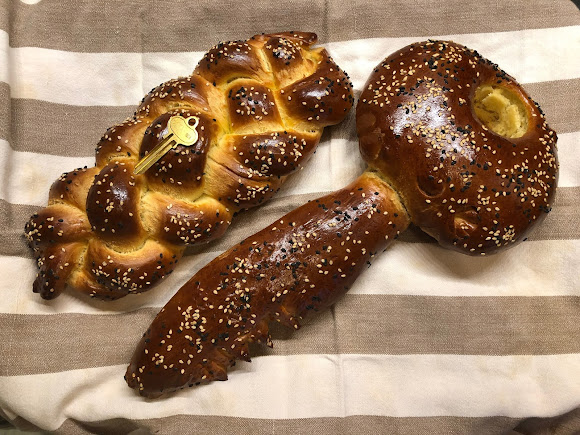שליסל חלה (Key Challah)
פּרשהבלאָג האָט צופֿעליק באַקומען אַ שליסל־חלה דאָס יאָר און האָט אַ טעאָריע װעגן אַ תּירוץ אױף דעם.
איך װאָלט זײער געװאָלט אַלײן באַקן אַ שליסל־חלה איבער אַ יאָר, מערצעשעם, אָבער איך בלײַב אַלעמאָל נאָך פּסחדיק אַ פּאָר טעג (אָדער װאָכן) , און װאָלט נישט געװען גרײט אױף חלה־באַקן.
 Parshablog has some ideas about possible reasons for the custom associated with the shabes after peysekh. of making a key challah (shlisl khale): a khale baked in the shape of a key, or a khale that has been stippled with a key, or a khale with an actual key baked into the dough. I found the picture above in The Hallah Book by Freda Reider, who writes that this form originated in eighteenth century
Parshablog has some ideas about possible reasons for the custom associated with the shabes after peysekh. of making a key challah (shlisl khale): a khale baked in the shape of a key, or a khale that has been stippled with a key, or a khale with an actual key baked into the dough. I found the picture above in The Hallah Book by Freda Reider, who writes that this form originated in eighteenth century
Marvin Herzog’s discussion of the geography of hallah decoration includes mention of traditional hallah ornaments including “birds, ladders, hands, keys, and other objects that might facilitate the ascent of prayers into heaven.” Herzog also cites Uriel Wienreich’s 1962 article “Culture Geography at a Distance: Some Problems in the Study of East European Jewry,” which demonstrates that the distribution of these designs was regional (32). These articles only mention dough shaped like keys, not baking actual keys in the dough.
I would love to try to make one of these next year, מערצעשעם, but I am usually not sufficiently de-peysekhified to undertake khale baking the first week after.
ETA: I did it! I made the challahs above in 2018 when we had a whole week between Akharon shel Peysekh and Erev Shabes. I made one challah with a blank key and another challah in the shape of a key.
Herzog, Marvin I. The Yiddish Language in
Reider, Freda. The Hallah Book,
Weinreich, Uriel. “Culture Geography at a Distance: Some Problems in the Study of East European Jewry” In W. L. Chafe (ed) Symposium on Language and Culture: Proceedings of the Annual Spring Meeting of the American Ethnological Society. 1962. 27-39.
Labels: English ענגליש, That old-time religion הײמישע ייִדן, Yiddish ייִדיש, חלה, פּסח













6 Comments:
דאס איז אן אונגארישע/חסידישע זאך. דו בּאלאנגסט צו די גרופּעס ?
װעלכע גרופּעס
?
For more on the background see here
For more on challah symbolism check out this link http://www.imj.org.il/exhibitions/2006/bread/ at the Israel Museum
also Margaret Glezer's wonderful book -- a blessing of bread
There is a tremendous amount of symbolism and ritual associated with bread in the Jewish religion
a simple jew,
great stuff, thanks!
fjk,
imj is down right now, but I will try again. I will have a look at Glezer's book when I can.
@@hello
This is a strange appeal on my part, but I have only recently discoverd that I must have had relatives names Schlussel Moses and Rachel Lea in Shlssyki, Topolince, Drohoviz ,the Ukrains. Since I saw that the origin of the Halla is also from the Ukrains, I wonder if there is any conncetion there. I have no one to ask because all of my immediate family know nothing about it. so please let me know if you ever heard the names Moses and CHana Malisdorf who I think were brother/sister to the Schlussel
Thank you for you response
Dr. Zafrira Malisdorf. Israel
Post a Comment
<< Home